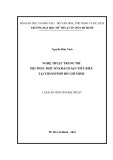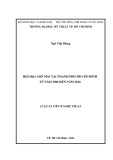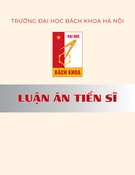
Harm Minimisation and Zero Tolerance: A Graffiti
Perspective
A Qualitative Study of Graffiti Management
Approaches
A thesis submitted in fulfillment of the requirements for the
Degree of Master of Arts by Research
Samantha Lee Spooner
B.A. Criminal Justice Administration (with Distinction)
School: Global Studies, Social Science, and Planning
College of Design and Social Context
RMIT University
April 2011

2
Harm Minimisation and Zero Tolerance: A
Graffiti Perspective
A Qualitative Study of Graffiti Management
Approaches
This mural depicts the work of an Aerosol Artist interviewed for this research. It is an
example of public art on display in the research setting.

3
Acknowledgements
Foremost, I wish to thank Dr Marg Liddell, who supervised this research. Her
tenacity, mentoring, guidance, and support have shaped not only this thesis, but
also my perspective on social justice. Marg‟s humour and encouragement have
assisted me throughout the writing process, and culminated in my growth as a
professional and a researcher. I also thank Michael Benes, not only for his
secondary supervision, but for encouraging me from the outset to take this
journey into the research world. I am also grateful to Marietta Martinovic, for her
advice and strategic direction in refining this thesis.
I am grateful to Anchor Community Care and Knox City Council for their trust,
flexibility, cooperation and assistance in enabling my access to participants for
this research. My heartfelt thanks are extended to the Coordinator of Knox City
Council‟s Community Safety and Emergency Management department. My
workplace supervisor Mr. Steve Pascoe has been supportive, encouraging, and
protective of my health and wellbeing whilst I worked full time and undertook this
thesis. He has provided space for me to question, explore and create meaning in
the research area and I am so lucky to have a boss who is outstanding.
I am indebted to the professionals in this field, who were so passionate about
young people and their inclusion in community life. The openness of their
perspectives, their generosity of time and honesty has assisted this research
significantly. To the exceptional young street artists who simultaneously
frustrated and inspired me, the way they both showcased and protected their
culture demonstrates the talent, maturity, and sophistication that define them - I
am so glad you allowed me into your world. I am especially grateful to the
individual street artist (Frankie) who allowed me to include pictures of his / her
freelance aerosol art within this thesis.
I gratefully acknowledge the financial contribution of the Commonwealth
Government, and the in kind support of RMIT administration.

4
My thanks to the „Top Paddock‟ Wantirna, for allowing me to undertake my
Masters supervision in your restaurant, whilst enjoying the best calamari I‟ve ever
tasted. The warmth and hospitality of management and staff has been amazing.
Finally, to my family; my Mum and Dad, my brothers and sisters, and my resilient
husband Matthew and my daughter Daisy, I owe you so much. Thank you for
believing that I could do this even in the times when I was not so sure. Your love
and support are what have sustained this incredible journey.
Thank you one and all.

5
Declaration by the candidate
I, Samantha Lee Spooner, declare that:
a) except where due acknowledgement has been made, this work is that of
myself alone;
b) this work has not been submitted previously, in whole or part, to qualify for
any other academic award;
c) the content of this thesis is the result of work which has been carried out
since the official commencement date of the approved research program;
and
d) any editorial work, paid or unpaid, carried out by a third party is
acknowledged.
Signed: …………………………………
Dated: ….……………………………………


























